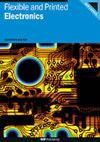使用天然还原油墨通过喷墨打印原位还原氧化石墨烯
IF 3.2
4区 工程技术
Q3 MATERIALS SCIENCE, MULTIDISCIPLINARY
引用次数: 1
摘要
生态友好型碱木质素辅助水基稳定氧化石墨烯(GO)墨水的开发提出了一种创新的方法,有可能通过可扩展的喷墨打印彻底改变印刷和柔性电子产品的制造。然而,氧化石墨烯缺乏导电性,需要额外的还原步骤来恢复其电性能。传统的使用有毒药剂或高温还原的方法由于环境危害而不适合大规模生产。使用天然物质的原位还原技术为通过喷墨打印精确还原氧化石墨烯印刷图案提供了一种有前途的、具有成本效益的、连续的解决方案。然而,对天然基喷墨可打印还原油墨的研究还很有限。在这项工作中,生产了原位喷墨可打印的天然还原油墨,并将其印刷在go印刷图案上,以进行还原过程。研究了减少的印刷图案的结构、官能团、形态和电阻。抗坏血酸还原样品的I - D/I - G比值从1.058增加到1.15,层间距离从0.395减小到0.385 nm。原子力显微镜表面分析表明,抗坏血酸还原样品的平均粗糙度显着增加了三倍,表明还原过程成功。抗坏血酸还原后的氧化石墨烯印刷图案的电导率为1250 S m−1,而未还原的氧化石墨烯印刷图案的电导率为0.43 S m−1,表明sp2杂化导电网络的恢复。本文章由计算机程序翻译,如有差异,请以英文原文为准。
In-situ graphene oxide reduction via inkjet printing using natural reducing inks
The development of eco-friendly alkali lignin-assisted water-based stable graphene oxide (GO) ink presents an innovative approach with the potential to revolutionize the manufacturing of printed and flexible electronics through scalable inkjet printing. However, GO lacks conductivity, necessitating an additional reduction step to restore its electrical properties. Traditional reduction methods using toxic agents or high temperatures are not suitable for large-scale manufacturing due to environmental hazards. In-situ reduction techniques using natural substances offer a promising, cost-effective, and continuous solution for precise reduction of GO-printed patterns via inkjet printing. However, limited research has been conducted on natural-based inkjet printable reducing inks. In this work, in-situ inkjet printable natural reducing inks were produced and printed on top of GO-printed patterns to carry out the reduction process. The reduced printed patterns were investigated for structural, functional groups, morphology, and electrical resistance. The ascorbic acid reduced sample showed an increase in the I D/I G ratio from 1.058 to 1.15, and the interlayer distance decreased from 0.395 to 0.385 nm. The atomic force microscope surface analysis showed a significant increase in the mean roughness by three times for the ascorbic acid-reduced sample, indicating success in the reduction process. The ascorbic acid reduced patterns also showed an electrical conductivity of 1250 S m−1 compared to 0.43 S m−1 for unreduced GO printed patterns, indicating restoration of the sp2 hybridised conductive networks.
求助全文
通过发布文献求助,成功后即可免费获取论文全文。
去求助
来源期刊

Flexible and Printed Electronics
MATERIALS SCIENCE, MULTIDISCIPLINARY-
CiteScore
4.80
自引率
9.70%
发文量
101
期刊介绍:
Flexible and Printed Electronics is a multidisciplinary journal publishing cutting edge research articles on electronics that can be either flexible, plastic, stretchable, conformable or printed. Research related to electronic materials, manufacturing techniques, components or systems which meets any one (or more) of the above criteria is suitable for publication in the journal. Subjects included in the journal range from flexible materials and printing techniques, design or modelling of electrical systems and components, advanced fabrication methods and bioelectronics, to the properties of devices and end user applications.
 求助内容:
求助内容: 应助结果提醒方式:
应助结果提醒方式:


